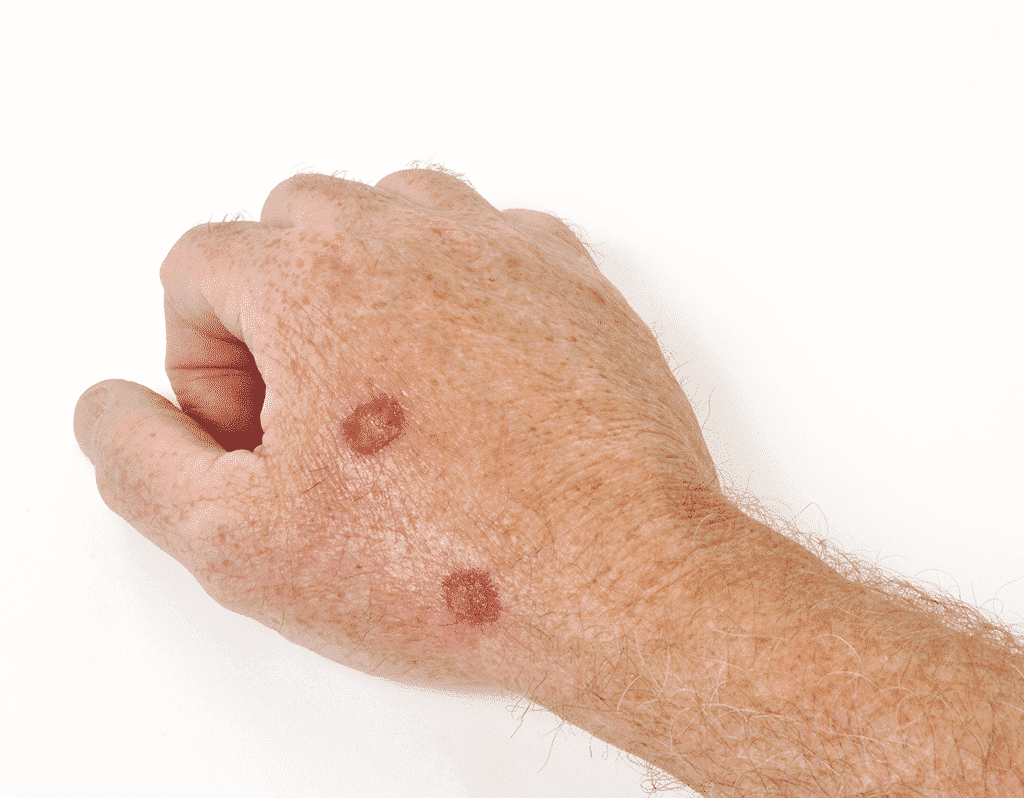Actinic Keratosis is the most common form of pre-cancerous condition. Skin damaged by chronic exposure to ultraviolet (UV) rays or tanning is the primary risk factor. Actinic Keratosis (AK) can develop into squamous cell carcinoma, one of the most common types of skin cancer.
If you are diagnosed with AK, the damage from long-term exposure to UV rays means you are at risk of developing future Actinic Keratosis. Your health care provider will work closely with you to treat AK and to help you devise a plan to protect your skin from further damage.
The AK patches are rough, raised scaly patches of skin that appear on areas most likely to see UV exposure such as the face, neck, and hands. These patches appear most commonly in older adults as they are usually the result of long-term UV exposure. If you notice patches like this anywhere on your body, make an appointment with your dermatology professional.
First steps to treatment
At your initial appointment, your dermatologist will ask you about the location of the patches you have noticed and will most likely perform a full-body skin evaluation. Your dermatologist might numb and then biopsy a small area of the lesion to confirm that you have Actinic Keratoses. If it is confirmed that you have AK, there are numerous potential treatment options. You will discuss these with your dermatologist to determine which options are right for you.
Treatment options for a Pre-cancerous Condition
The most common treatment for AK is cryosurgery. Liquid nitrogen is used to freeze the lesion, which will call redness and blistering. The lesion will then soon be replaced with new and healthy skin. Cryosurgery is the most common treatment for AK lesions and can be performed as a quick and relatively painless office procedure.
Surgical removal and biopsy might be used to confirm that it is AK and not squamous cell carcinoma. The surgical removal of the lesions may be curative and no further treatment will be required. If so, your dermatologist will have you back periodically for full-body exams to make sure no new lesions appear.
Topical chemotherapy may be applied to the lesions, or to the entire area that appears damaged by the sun. The treatment can take four to six months to work and will also cause redness, blistering and peeling.
Dermabrasion is an option that is sometimes used when a large area of skin is affected. Dermabrasion consists of a handheld device being used as a sander to remove the top layer of skin, leaving the skin red and raw. It can be a painful procedure, so talk to your dermatologist about using topical numbing or pain medication for the procedure.
Photodynamic therapy is a treatment option that consists of a chemical being applied to the skin. A particular type of light is used to activate the chemical that will then destroy the abnormal skin cells. This procedure may lead to changes in the pigmentation of the affected skin.
Chemical peeling is done by applying a chemical solution to the skin that causes blistering and peeling of the area where the actinic keratosis is located. Temporary redness, pain, and swelling can occur, but your dermatologist can prescribe creams or other medications to help relieve the discomfort.
Whatever treatment option your dermatologist proposes, ask questions to make sure you understand the procedure and what type of aftercare will be needed. It is critical that you know your risk of future episodes of AK and that you will need regular follow-ups with your dermatologist. Remember, catching a pre-cancerous condition early is the best method of treatment that gives you the greatest chance for the best possible outcome.
Catching AK, while it is still a pre-cancerous condition, helps you avoid more extensive and possibly disfiguring treatment in the future. Once diagnosed with Actinic Keratosis, it is not too late to prevent further damage by practicing sun safety.
To avoid further sun damage:
- Wear a high SPF sunscreen every day, even in the winter.
- Avoid the sun during the brightest part of the day, usually between 12:00 p.m. to 5:00 p.m.
- Wear a hat when you must be outdoors, and make sure it protects your face, ears, and the back of your neck.
- Wear sunglasses that are labeled to protect against 99% of UV rays. This helps to protect your eyes themselves and the delicate skin around your eyes. The wider the lenses the more of your skin will be protected.
- Clothing is your best protection against developing a pre-cancerous condition, especially if they are a dark color and made of tightly woven fabrics.

